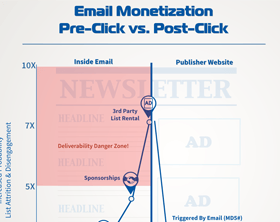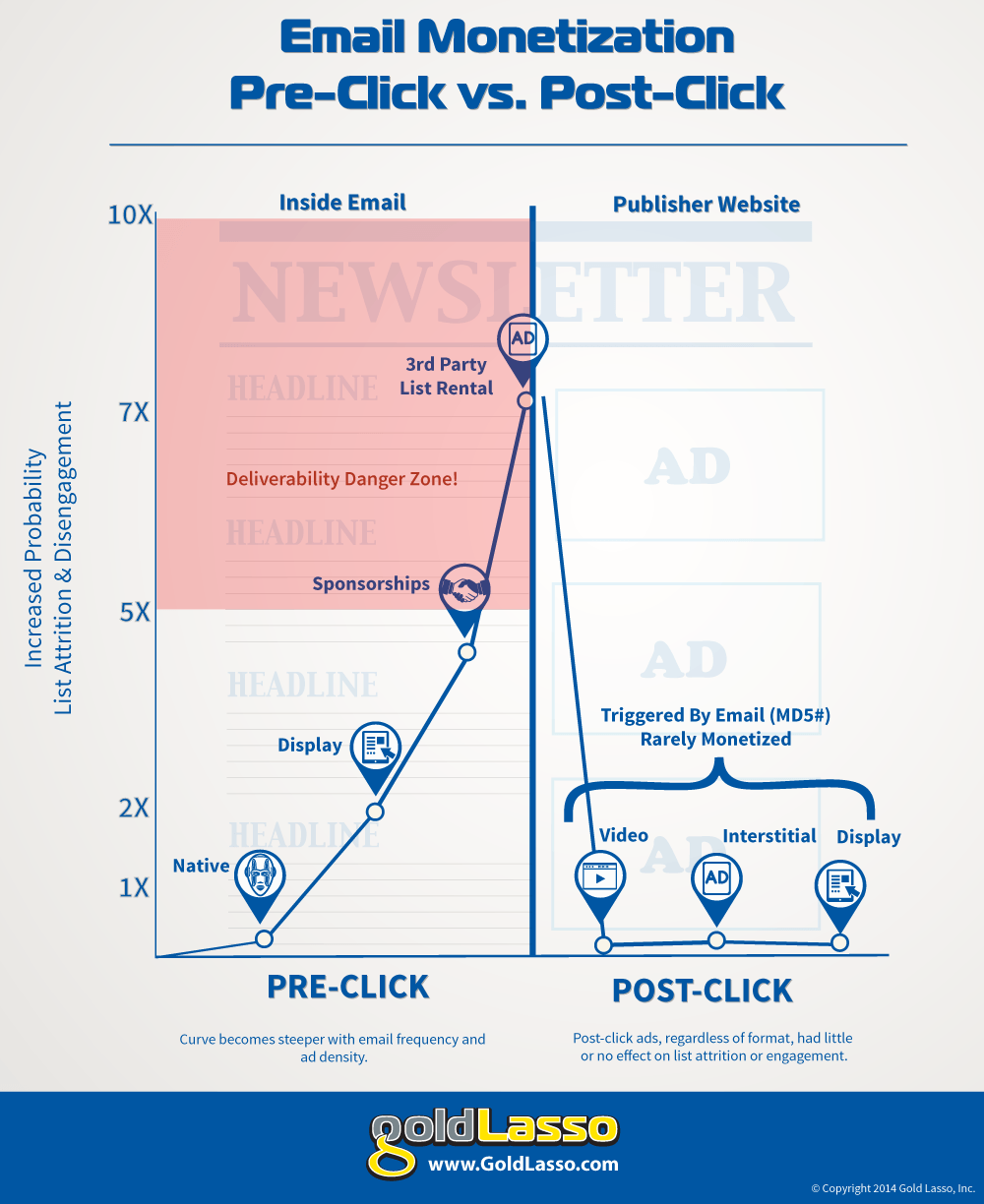The From Line
As published in MediaPost
Native ads are hot! This controversial yet ultra-effective tactic of blending content, advertisement, and placement is heading straight for consumers' inboxes. With a firm hold on the social channel, native ads are quickly making their way to the email channel where they are a natural fit for mobile newsletter formats. Despite the initial success of native ads, many email publishers are fumbling with their implementation and optimization. Here's some help.
Eye Movement
The successful implementation of native ads in email starts with the format of the email message itself. Email formats are now highly influenced by the success of social media on mobile devices. For example, Facebook made a fairly smooth transition from desktop to mobile, as it was able to scale the value of its social stream to a smaller format. The same challenge for email is achieved via adaptive design, compacting all of an email's content into one narrow column. This one -olumn format significantly increases an email's legibility and engagement, especially on mobile devices, by allowing a subscriber's eye to effortlessly scan from left to right while scrolling.
Native Art
Ideally, all aspects of a native ad's format should be identical to the main content, with the exception of disclosures and labeling. This includes headlines, colors, fonts, image sizes and any other characteristics of the email's native design and format. While some might consider the prior suggestion controversial and even counterintuitive to traditional journalism ethics, others argue that when publishers adopt native ad formats, they send subscribers a message that this content is advertising -- and that their editorial is equally important to their business. After all, you can't have quality content without a solid revenue base to support it. Regardless of your stance, there should be no argument on proper and visible advertising disclosures.
Placement Science
To maximize return on native ads, placement becomes just as critical as format. When using a one-column format, native ad placement in email is easy, yet should be tested extensively while ignoring intuition. An example of letting intuition trump science is not placing a native ad at the top of an email's news stream because an advertisement as a top story goes against the norm. Despite whether this is true or not, publishers who rely on science for placement always fare better then the ones who rely on old-school intuition.
Contextual vs. Personal
Contextual and personal native ads are the two types publishers are currently experimenting with in email. Contextual is easier to implement, as there are fewer targeting and content variables to consider. Personalized content, on the other hand, is much more difficult, since publishers need to be armed with both a deep and diverse ad inventory, as well as with individual targeting capabilities. Unless you are a publisher of a micro-niche subject, it's been proven that personalized native ads mostly outperform contextual ones.
As always, email eventually finds a comfortable role whenever there's a digital media transformation. For now, email is successfully providing extended reach for native ads, while facilitating targeting and testing, resulting in additional publisher revenue.
Elie Ashery is the CEO of Gold Lasso and an adjunct professor at the Robert H. Smith School of Business.
As published in MediaPost
Email newsletter monetization
When publishers think about email newsletter monetization, the first things that come to mind are usually list rentals, sponsorships, and display ads. While these typical pre-click monetization tactics work well, they often have inherent risks such as subscriber disengagement, list attrition and deliverability issues.
What if there was a more elegant way to monetize email? While most publishers focus on the real estate inside an email for monetization opportunities, they often overlook the most valuable parcels containing complete subscriber attention: the post-click.
Email post-click monetization
Every experienced publisher knows that the actual value of email is not in the opens, but in the clicks. The open statistic is just a prelude to the end goal of focusing a subscriber's attention to valuable content and revenue-producing advertising. Knowing this, nothing is more attention-grabbing than the anticipation of what's on the other side of a click. A quick shot of dopamine commits the subscriber to focus intently on what will happen next. This prime email real estate, the process of going from email to website, the post-click, is what gets squandered the most when publishers monetize email.
Thankfully, there are now targeting methods allowing publishers to monetize this neglected post-click real estate efficiently, without sacrificing list attrition or subscriber engagement. One recent email monetization study by Gold Lasso concluded that most pre-click tactics provide a 2 to 7 times increase in subscriber attrition or disengagement, while post-click tactics have no effect.
Ironically, many of these post-click methods are the same as pre-click (inside the email) but are repurposed for the post-click opportunity. The most prevalent example is leveraging an email address's MD5# or encrypted version. Aside from email marketing, the email address is now serving a multitude of purposes such as creating custom audiences on social networks and providing new revenue opportunities for publishers. Many ad networks now allow publishers to submit an email address's MD5# (instead of a cookie) to return a dynamically created personalized ad. Meaning, everything that you once did inside your email, you can now do outside your email, including video targeting.
Measuring the value of these new email monetization tactics is relatively easy. Basic CPM, CPC, and click-through rates will suffice. Most important, there are no opportunity costs, since most publishers fail to take advantage of email post-click opportunities to begin with.
Measuring the risk associated with these tactics is different. Raw email statistics such as opens, clicks and opt-outs are important, but applying a new combination of ratios can reveal a more telling story. The first new statistic publishers need to be mindful of is the open to click-through rate: that is, the total or unique clicks divided by the total or unique opens (clicks/total opens). If subscribers are conditioned to know they will see an interstitial or targeted ad unit, and are vehemently opposed to the practice, they won't click an email link. If this happens this statistic will fall precipitously, resulting in lower email engagement.
The second statistic is the click to opt-out rate, calculated by dividing the number of opt-outs by the total or unique clicks. If this statistic rises after implementing a post-click monetization program, the increase signifies greater than normal list attrition. To get a better understanding of your program's risk, it is best to compare these statistics to both before and after its implementation.
Despite some initial reservations by publishers, almost all realized that post-click email monetization programs provide new revenue opportunities with minimal risk.
About This Infographic
Do different email monetization tactics affect list attrition and engagement differently? This is what our publishing partners wanted know so we decided to study their monetization practices in detail and some of the results were contrary to typical publisher thinking. We wanted to focus our research on a couple of statistics that could easily be measured but reveal what the true risks of various monetization tactics actually are. Therefore, probability of disengagement and opting out was attributed to subscribers who were exposed to various email monetization tactics. This included over 400,000 randomly selected subscribers across 20 publishing partners employing different and overlapping email monetization tactics. Based on our findings, there’s no surprise that pre-click email monetization tactics (monetization inside an email) significantly increased the probability of list attrition and disengagement.
Native advertising, ads placed in the main content column of an email, had the least effect on attrition and disengagement while 3rd party list rentals increased the probability of a subscriber opting-out or ignoring future messages by over 700%. More importantly, despite the high returns of list rentals, they created dire deliverability issues to future email sent. Contrary to common publisher misconception, however, all post-click email monetization tactics (interstitials, videos, display ads, etc.) that leveraged a subscriber’s encrypted email address for targeting purposes, had very little to no effect on list attrition or disengagement. In other words, publishers who don’t leverage subscriber email addresses for post-click targeting and monetization purposes are leaving low risk to no risk money on the table.
Use This Graphic for FREE on Your Site!
You may use the infographic above on your website, however, the license we grant to you requires that you properly and correctly attribute the work to us with a link back to our website by using the following embed code.
Embed Code
<div>
<a href="/images/easyblog_images/63/Newsletter-Monetization-Curve.png" target=
"_blank"><img src="/images/easyblog_images/63/Newsletter-Monetization-Curve.png" alt=
"infographic" width="430" /><br />
Click to Enlarge</a><br />
Via <a href="/blog/entry/354-infographic-post-click-email-monetization-study">Gold Lasso, Subscriber Engagement & Monetization Systems</a>
</div>
Infographic Thumbnail




